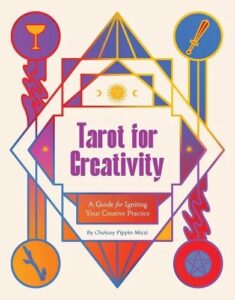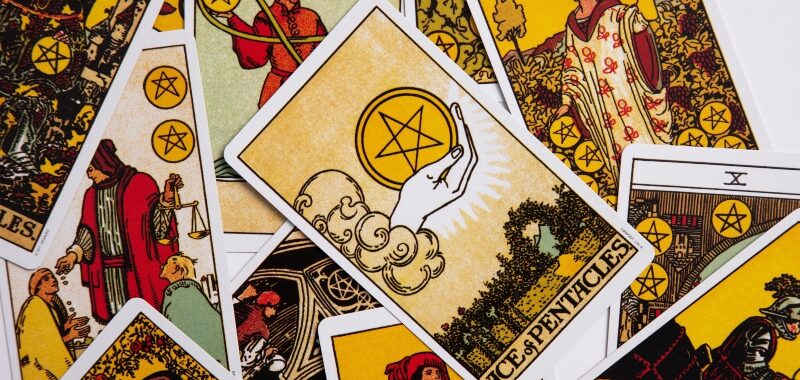The first time a friend convinced me to let her read tarot for me, I was reluctant: I didn’t want to know the future. I didn’t want to feel defined by a psychic prediction I had no agency over. Today, that remains true. If it feels ironic that despite this, I now read tarot for a living, it’s because the mainstream perception of divination rarely gives the cards credit for their wide application beyond future-gazing.
Article continues after advertisement
Here is what I’ve found: the tarot, in psychic hands, may indeed function as a fortune-telling device, but for us mere mortals, this pack of 78 images printed onto cards has a different, but equally magical purpose: it facilitates storytelling.
Within these cards are what the novelist and tarot expert Rachel Pollack called “78 degrees of wisdom”—portals of possibility and guidance that allow us to examine our life experiences by unpacking memories, desires, and fears we know intimately, but may have never thought about in context with the wider narrative of our lives.
For us mere mortals, this pack of 78 images printed onto cards has a different, but equally magical purpose: it facilitates storytelling.
But the tarot can be more than a tool for exploring and reflecting on the story of your life—the cards can pave the way to help you tell that story to readers.
In her memoir, Vesper Flights, author and naturalist Helen McDonald observes “how unerringly the cards reflect my deepest states of being, emotions I’d not let myself feel at the time.”
Autofiction author and memoirist Alexander Chee, whose Substack “The Querent” takes its name from the formal title given to a person receiving a tarot reading, has written often about his relationship with the cards. In a piece published this summer, Chee remarked: “What I like about the Tarot is how it makes me think of my life holistically.”
Sylvia Plath drew on tarot imagery to examine her thoughts and experiences in such poems as “The Hanging Man,” “Daddy,” and “Ariel.”
The tarot can help you reflect on your deepest states of being, in Chee’s words, “look holistically” at your life, and ultimately create art from the stories you find waiting for you when you explore your experiences through the lens of the cards.
Here are four methods you can play with to help you leverage tarot cards as tools for exploring your life stories and transforming them into personal essays and even full-length memoirs:
Use a tarot spread
A spread is a combination of tarot cards laid out on a table (or floor!), with each card correlating to a specific meaning. Spreads give tarot cards additional context and narrative shape, and can help you ideate and identify the big story points and subject matter of an essay or book.
The simplest, most classic spread is “Past, Present, Future,” in which three cards are drawn: one to represent past circumstances, one to represent present circumstances, and one to represent future opportunities or new paradigms.
You can use this spread to make notes on what memories, experiences, desires, and fears can illustrate your life stories. To experiment with this method, draw three tarot cards and place them on the table, assigning each one to represent “Past” “Present” or “Future.” Review the cards you draw and explore how they can help you craft a personal essay, chapters, or scenes in a longer form project. You can also draw cards in this structure to reflect on and/or generate the overarching storyline of a book-length memoir.
For a more in-depth experience, you can draw cards in a ten-card Celtic Cross spread formation, and take notes on how each card represents an experience from your life, then combine those experiences into a full story.
Note: You absolutely do not need to know the prescribed meaning of every card to work with tarot spreads—or to use any tips that follow, for that matter. Give yourself full permission to lean into your creative interpretation of what any given card means to you, and what it reflects in your own life. If you are a total beginner with no tarot knowledge, I recommend using a Rider Waite Smith tarot deck—every card in this version is fully illustrated, which will give you much more creative license and room to play than older, “Marseille-style” tarot decks, where only about half the cards are fully illustrated.
Draw out thematic threads using tarot suits
The tarot is divided into two parts: The Major Arcana, and the Minor Arcana, which is further divided into four suits: The Cups, The Pentacles, The Swords, and The Wands. Each suit has a strikingly different tone, and tells a different thematic story. If you have a sense of the story you want to tell already through your essay or memoir, you can use the suits to help you further ideate and explore while staying on theme.
Tarot can be more than a tool for exploring and reflecting on the story of your life—the cards can pave the way to help you tell that story to readers.
To try this, separate your deck out by suit, and set the Major Arcana aside. Choose a suit that you feel most closely matches the mood, theme, or energy you want to convey through the story you’re telling. Then try to generate material about that theme by writing in response to the images of all 14 cards in the suit. Pay attention to any patterns that arise as you write through the cards: do multiple cards bring up the same experience or subject related to your theme? Which cards feel intimately personal to your experience, and which cards invite you to widen your aperture and look at your story through a broader point of view?
Challenge yourself to write 500 words about how each card relates to the theme of your essay or book, and see how much material you can generate.
Chart your transformation though individual tarot archetypes
You can help yourself clarify your story by using the cards to identify who you were at the story’s outcome, and who you become by the end.
You can focus specifically on the 22 Major Arcana cards (starting with The Fool, numbered 0, and the World, numbered 21 or XXI) for this exercise. Look through the deck and intentionally choose a card that you feel represents your mindset when the story begins, and choose a card that represents how the reader will find you at the story’s close.
Write about what it takes to get you from card A to card B, and what experiences you need to write up into scenes to illustrate that transformation.
You can also try choosing two or three additional cards that represent important moments along the journey from beginning to end, then reflect on—and write about—the role that each of these versions of you play in the story you wish to tell about your life.
Generate a full first draft using all 78 tarot cards
If you want to speed through what Anne Lamott lovingly coined the “shitty first draft,” tarot is a great way to generate material and save yourself the blank-page fear of having no idea where to begin.
Every day, draw a tarot card. Note down some experiences, people, hopes, dreams, fears, and reflections from your life that the card brings to mind. Write 1,000 words in response to that card.
If you like, you can reread the previous day’s material and reflect on what might come next in the story, and write about that, in addition to your tarot-fueled generative writing for the day.
Be consistent in this practice, working through the deck until you’ve written in response to all 78 cards. Do this, and in less than three months, you will have generated 78+ scenes/sections and nearly 80,000 words (the length of an average manuscript).
Will you need to edit this tarot-generated manuscript to pieces? Of course—what first draft doesn’t drown in red pen?
Will you have a wealth of meaningful, raw material to carry you into the next phase of your drafting process? Most definitely. What arises through this first, card-assisted draft will unearth crucial information that informs later versions.
Will the tarot have completely overhauled your approach to telling the story of your life?
I don’t need to pull a card to feel confident the answer is yes.
__________________________________

From Tarot for Creativity: A Guide for Igniting Your Creative Practice by Chelsey Pippin Mizzi. Copyright © 2024. Available from Chronicle Books.

